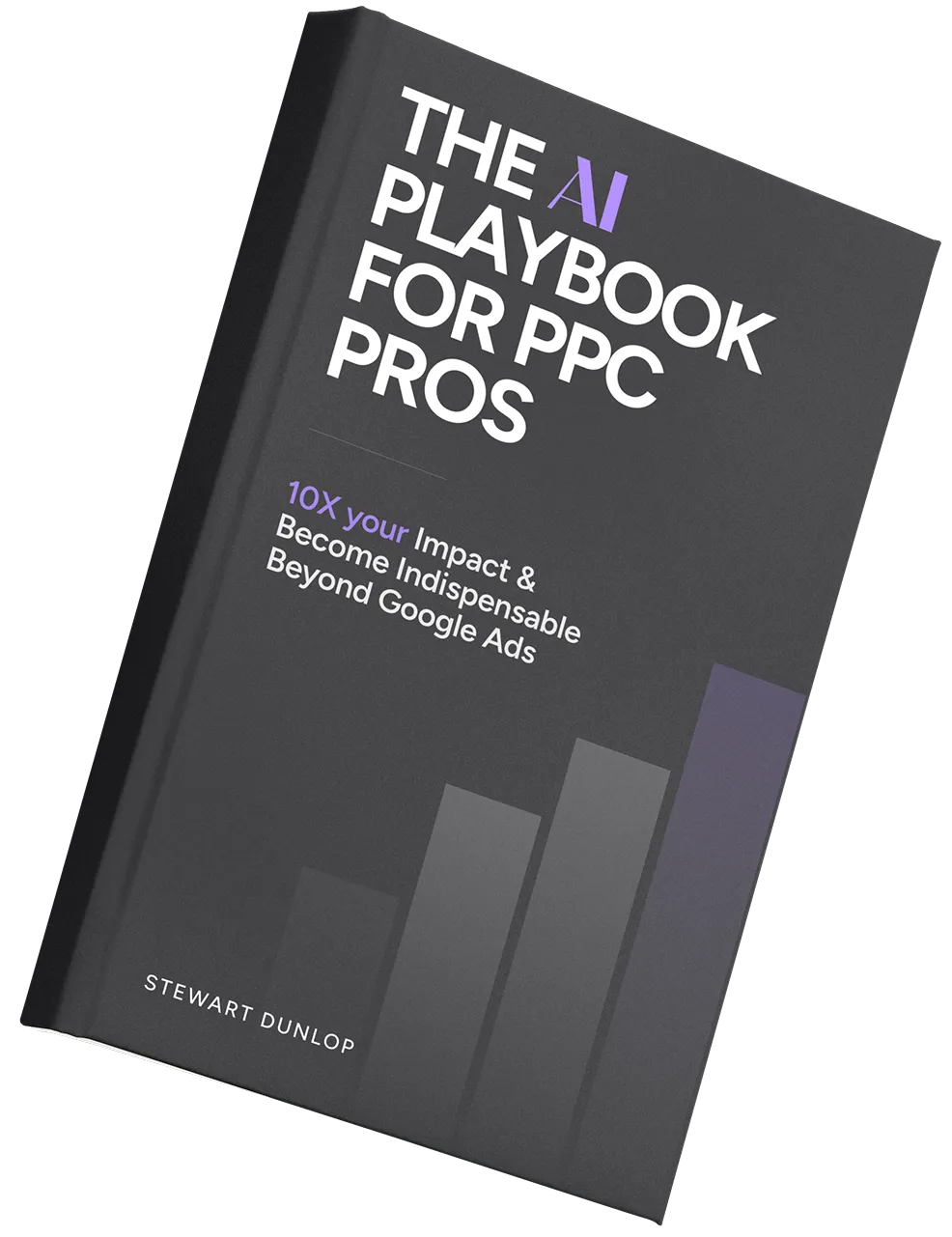
According to Gartner’s CMO Spend and Strategy survey, 74% of marketing managers planned to increase or maintain their PPC investment in 2023.
This is because it is effective for driving traffic, generating leads, and achieving ongoing results for businesses.
PPC campaigns allow organizations to:
🎯 Target specific audiences.
🎯 Track their return on investment (ROI).
🎯 Adjust spending to match their advertising budget.
Getting the most out of PPC requires good campaign management.
You could do this yourself but PPC management requires a lot of time. Plus you need to develop the experience and expertise to pull off great campaigns.
A better option may be to hire a PPC manager—this could be a freelancer or an employee. Or you could hire a PPC management company.
This article outlines the duties of a PPC manager so you understand what’s required to run successful PPC campaigns.
💡 What Is PPC Advertising?
PPC stands for “pay-per-click,” because you’re only billed when customers click on your ad and actually visit your product’s landing page.
This article focuses on sponsored search ads on the Google Ads platform. But PPC is available on a number of different platforms and in a number of different formats.
If you’re new to PPC and want to learn the basics, we suggest checking out our article on PPC for small businesses.
What Does PPC Management Entail?
PPC management involves setting up and monitoring PPC advertisements, and reporting on their performance.
This is usually handled by in-house marketing teams, digital marketing agencies, or freelance specialists.
They’re responsible for:
✅ Overseeing accounts across multiple ad networks.
✅ Crafting campaigns for each account.
✅ Implementing well-thought-out strategies to maximize lead generation.
✅ Optimizing campaigns for the highest ROI.
This section explains what the role of a PPC campaign manager involves. We’ve based it on a Google Ads campaign as it’s one of the most popular PPC platforms:
1️⃣ Set your PPC campaign goals
The first task of an in-house PPC manager is to determine what they want their company’s PPC campaigns to achieve.
This involves understanding the company’s overall business objectives.
Let’s say you offer a cloud-based streaming service that users can subscribe to for unlimited access to documentaries. You want to increase the number of subscribers from 1,000 to 5,000.
PPC management doesn’t have to hit this target on its own. You’ll also have other marketing strategies such as SEO tactics and content marketing efforts.
However, a PPC campaign could, for example, contribute by gaining 1,000 subscriptions over the next three months.
PPC managers are also responsible for setting realistic budgets for their company’s PPC ad spend to yield the desired results.
This involves balancing aggressive spending for quick results with conservative spending for better ROI.
According to WebFX, PPC campaign costs usually fall within the following ranges:
💸 Cost per click: $0.11 and $0.50
💸 Cost per 1,000 impressions: $0.51 – $1.00
💸 Monthly overall cost of running ads: $100 – $10,000
Let’s say your PPC manager determines that $5,000 per month will gain 1,000 subscriptions over the next three months.
At this point, your PPC manager will also identify metrics to measure whether your campaign has been successful.
They will collect these metrics throughout the campaign and regularly report on progress. This will allow them to adjust the campaign if it is not achieving their goals.
Here are metrics you should track to measure the progress of your campaign goals:
📊 Click-through rate (CTR): If your PPC ad was displayed 10,000 times and 500 users clicked on it, then your CTR is 5%.
📊 Cost per click (CPC): If your PPC campaign budget is $5,000 per month and you received 500 clicks in a month, then your CPC is $10.
📊 Conversion rate: If 50 out of the 500 users who clicked on your PPC ad subscribed to your streaming service, then you have a conversion rate of 10%.
📊 Cost per acquisition (CPA): Given the $5,000 monthly budget and 50 new subscriptions acquired, you will have a CPA of $100.
📊 Return on ad spend (ROAS): If your PPC campaign generated $15,000 in revenue over the three months, and you spent $15,000 on advertising, then your ROAS is 100%.
📊 Subscriber growth rate: Let’s say you started with 1,000 subscribers and gained 50 new subscribers from the PPC campaign in three months. That’s a 5% growth.
📊 Ad impressions: If your PPC ad was displayed 10,000 times, then you have 10,000 impressions.
2️⃣ Get your ads account ready
If you don’t already have a Google Ads account, then your PPC manager will need to get one set up.
Once this is set up, they can launch your first campaign. This involves:
👉Setting objectives
👉Setting a budget
👉Choosing targeting options
Each campaign tends to focus on a specific product, service, or PPC marketing goal.
Within each campaign, you can have multiple ads, which are organized into groups. Each ad group usually targets the same or similar keywords or audiences and may have a similar design or content.
Each ad consists of the following elements:
🔑 Keywords
🎨 Ad creatives
🔗 Ad extensions
💰 Bidding
🛬 Landing pages
We explain what each of these elements entails in the next section.Here’s a visual breakdown of how the different elements of your account are structured:
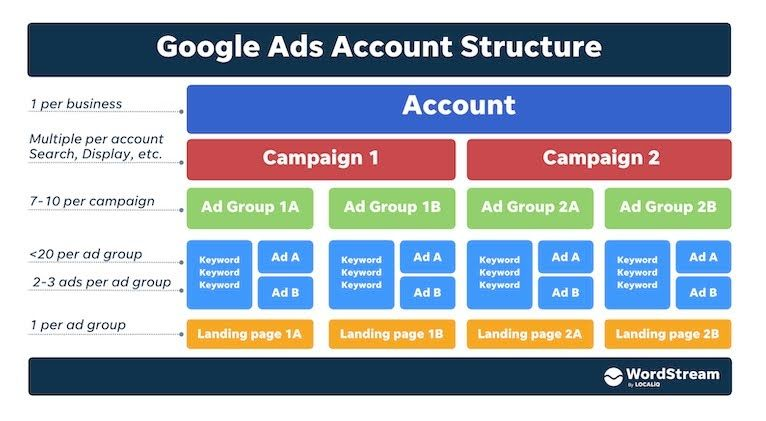
Setting up a Google Ads campaign, excluding content creation, could take anywhere from several hours to a day, depending on the complexity of the campaign.
A PPC manager would meticulously organize these campaigns into ad groups, ensuring each group targets specific keywords and audiences.
After setting up the structure, they would fine-tune targeting options such as locations, demographics, and devices to optimize campaign performance.
3️⃣ Create your PPC campaigns
Once the campaign structure has been set up, you can prepare content for each ad group.
This will include the following tasks:
🔑 Keyword research
When someone types something into a search engine, it is called a “search query”. Keywords allow you to choose which search queries you want your ad to appear for.
Let’s think back to our example where you’re running a streaming service for documentaries.
If you’re trying to increase the number of subscribers to your documentary streaming service, you need to understand what potential customers will search for.
Start by conducting keyword research:
🔍 Brainstorm seed keywords: This involves sitting with your team and outlining the core keywords and phrases directly related to your business. For example, this may include terms like "stream documentaries" or "watch documentaries online.”
🔍 Expand with keyword tools: You can use SEO tools such as Ahrefs and SEMRush to expand your list of keywords. In this case, you might learn that terms like "best documentaries to watch" are often searched for by your target audience.
Once you have a list, you should analyze each term’s:
🔍 Search intent: When a user types in a search term it indicates what they want to do. For example, someone typing in “best documentary streaming service” is likely to want to buy your services. However, someone searching for “best documentary series 2024” is probably looking for a viewing recommendation. Think about your campaign objectives and decide if it aligns with the user’s search intent for each keyword. In our case, we probably want to choose keywords with a high intent to buy.
🏆 Competition: This is the number of other PPC campaigns targeting a keyword. The more campaigns targeting it, the higher the CPC. However, high-competition keywords often have greater potential earnings and more traffic.
This will help you refine your list. You’ll ideally want between 5 and 20 keywords for each ad group.
💡 Try this PPC strategy: Negative keyword-matching techniques
This prevents ads from being triggered by search queries that are not relevant to your product.
For example, adding negative keywords, such as "free" would prevent the ad from showing for searches like "free documentary streaming".
🎨 Ad creation
You need to ensure your ad grabs potential customers’ attention and encourages them to click on it.
You can do this by making sure you use high-quality copy alongside eye-catching visuals or compelling offers.
When you write the copy for your ad, place yourself in potential customers’ shoes and ask yourself what might intrigue them.
For search ads, you won’t have a lot of visual freedom. However, by including relevant keywords in your ad copy, you can improve its relevance and visibility.
Other types of ads do use video and designs. For these campaigns, make sure everything you use is professionally produced.
Here’s an example of a PPC ad by a streaming service on YouTube:

This ad includes an eye-catching video, as well as a modern banner with clear images and easy-to-read text.
Make sure to create two to three versions of your ads so that you can test them to determine which version performs best.
💡 Try this PPC strategy: Optimize your landing pages
After clicking on your ad, potential customers will be redirected to your chosen landing page.
You need to make sure that this page is designed well, that it’s responsive on mobile devices, and that the content is compelling and engaging.
🔗 Ad extensions
These are short, hyperlinked phrases that provide users with additional information, ideally prompting them to take action.
For example, if someone searched for “stream documentaries,” they might find this real-life search ad:
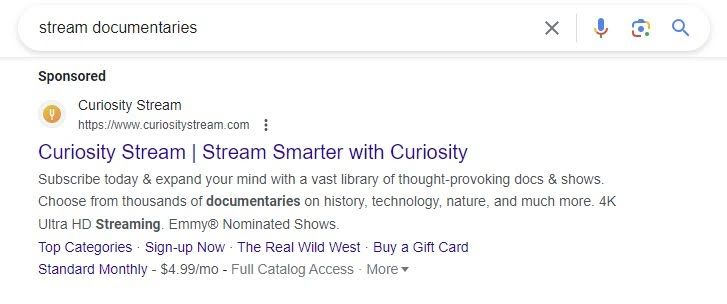
Below the main ad copy, you’ll notice clickable keywords and phrases that lead to specific pages, such as “Top Categories,” “Sign-up Now,” and “Buy a Gift Card.”
This helps the reader find what they are looking for.
There are many different kinds of extensions, including:
📞 Call extensions: These redirect users to call the business from the ad itself.
🗺️ Location extensions: These display the business's address and proximity to the user.
It’s important to note that this approach isn’t limited to search ads.
In display ads, you can use call-to-action buttons, promotional extensions, or app extensions to provide additional information and encourage user engagement.
Here’s an example of a display ad with an ad extension that says “Shop now”:

Similarly, in video ads, you can incorporate ad extensions like interactive cards or end screens to encourage viewers to take action or provide more context about the advertised content.
💡 Try this PPC strategy: Make extensions mobile-friendly
Many users view ads on their cell phones. Therefore, make sure your ad extensions are optimized for mobile devices.
This includes using clickable phone numbers in call extensions and providing information that’s easily readable on smaller screens.
💰 Bid management
This involves setting how much you are willing to pay for each click. Once you have set this, Google Ads automates an auction for each keyword.
The winning bids are more likely to be shown.
💡 Google Ad Rank
Your bid isn’t the only factor that Google uses when choosing which ads to show.
Others include:
🤔 The relevance of your ad and landing page to the keyword
🤔 The quality of your ad and landing page
🤔 The context of the person’s search (for example, their location)
🤔 The number of useful ad assets you provide (like a phone number)
These contribute towards a score called Google Ad Rank. The ads with the highest Ad Rank score will be shown to users.
This means that your ad could be shown even if you don't have the highest bid.
You can bid manually, which involves setting individual bid amounts for each ad group, or you can use algorithms to automatically adjust bid amounts.
Setting your bids can be based on predetermined goals, such as maximizing clicks, conversions, or ROAS.
For example, if you set a target cost per acquisition (CPA) for each conversion, Google will automatically adjust your bids to meet this goal within your available budget.
💡 Try this PPC strategy: Adjust bids during peak hours
This allows you to increase or decrease your bids based on the time or day of the week when your ads perform better.
For example, if you notice that your conversion rates are higher over weekends, you can increase your bids during those times.
🛬 Landing pages
This is a page on your website that people are sent to when they click your ad.
These aren’t created in Google Ads, but they are important parts of your campaigns. You need to have it ready before you launch your campaign.
Landing pages encourage visitors to carry out your campaign’s call-to-action (CTA).
Your landing page CTA could be:
🖱️ Buy a product or service
🖱️ Sign up for a free trial
🖱️ Sign up for a webinar or demo
🖱️ Find out more information
🖱️ Subscribe to a newsletter
A good landing page will:
🛬 Meet the visitor’s needs
🛬 Build trust
🛬 Convert visitors using a strong CTA
🛬 Tell people everything they need to know to follow your CTA
🛬 Allow people to contact you
Take a look at this example from documentary streaming service Curiosity Stream.
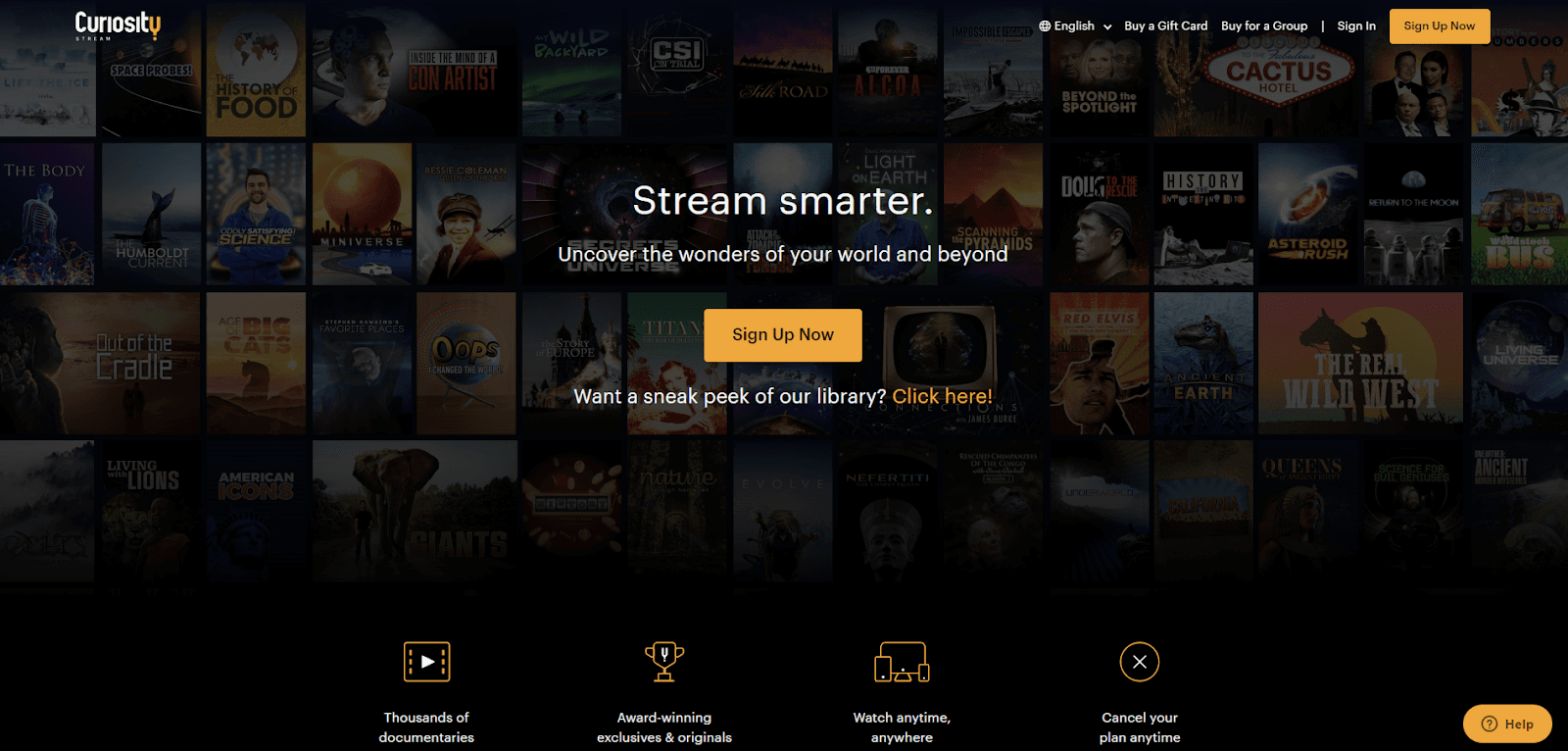
Here’s why it works:
✔️ Includes a clear CTA to sign up for a subscription
✔️ Lists the service’s benefits
✔️ Links to more information about the content on offer
✔️ A chatbot allows visitors to get in touch
✔️ Includes information on pricing
✔️ It guides visitors through the sign-up process step-by-step
✔️ Has strong branding and professional design
It’s important your PPC manager works with professional copywriters, designers and developers when creating landing pages.
4️⃣ Monitor, optimize, and report on performance
PPC managers are responsible for overseeing the entire campaign process.
As soon as a campaign is launched, they need to monitor its performance and continuously adjust it so that it improves.
If campaigns are left unattended, they may underperform, resulting in wasted ad spend and missed opportunities.
PPC managers need to check in on their campaigns at least once a day–especially during the initial stages of a new campaign launch.
Once campaigns end, PPC managers draw up reports that outline their campaigns’ performance.
This is a long process and your PPC manager should collect information to determine whether your goals were met or not.
Google Ads has a dashboard that can provide you with this information.
Here’s what it looks like:
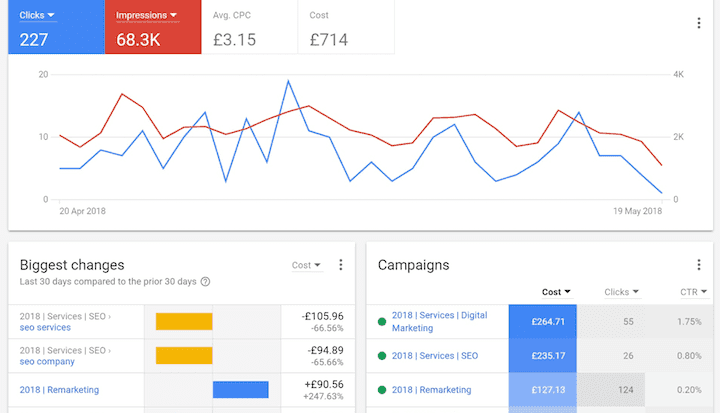
If we return to our documentary streaming service, it would be important to track conversions and subscriber growth rates.
The report should include an analysis to determine whether the campaign goals were achieved and supported by the collected data.
At the end of your report, you can summarize your results, which can be used as a frame of reference for future campaigns.
Here’s an example of what your report might look like:
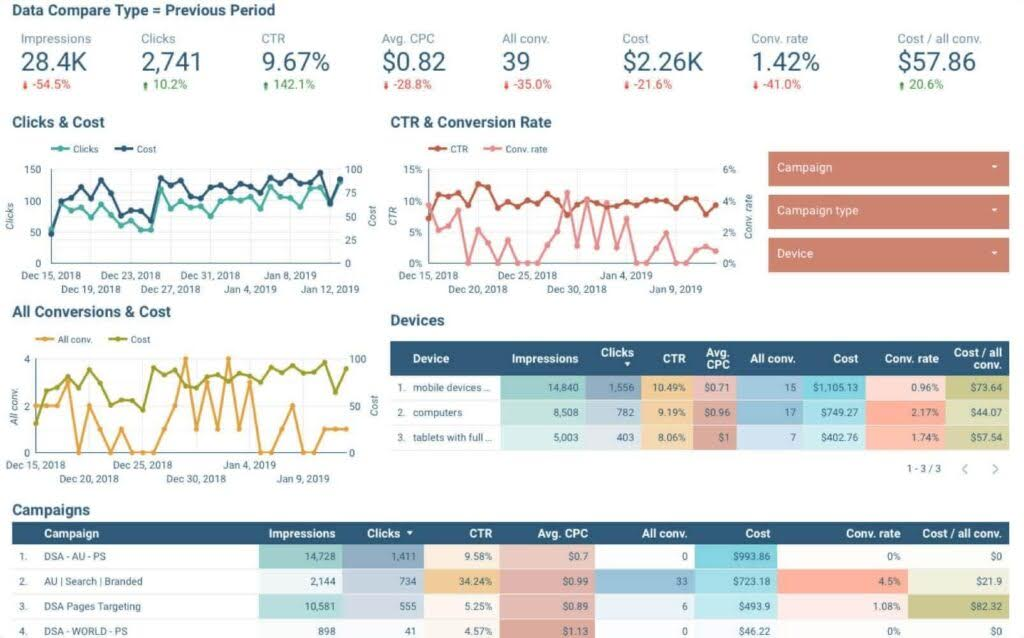
How PPC Management Software Can Help
When it comes to PPC management, you don’t have to do all the work manually.
There’s software available that you can use for:
🛠️ Data analysis and budget control: This should give you detailed insights about your campaigns that will help you create reports and manage your budget better. For example, Agency Analytics offers great data analytics tools.
🛠️ Keyword research: This helps you identify high-performing keywords for your campaigns. For example, Ahrefs provides insights into search volume, competition, and potential performance metrics for each keyword.
🛠️ Campaign efficiency: This helps you automate repetitive tasks, which could save you time and resources. Both Optmyzr and Acquisio automate various PPC management tasks, along with other features such as bid optimization and A/B testing.
PPC management software can make a huge difference when you’re trying to run multiple campaigns. If your budget allows it, consider making use of these tools.
Learn more about the best PPC software tools for campaign management.
What Will PPC Management Cost?
If you decide to use tools, you can expect to pay:
💳 Agency Analytics: Their “freelancer” plan, which is their entry option, costs $12 per month, but it goes down to $10 per month if you purchase an annual plan.
💳 Ahrefs: Their most affordable plan starts at $99 per month, which is ideal for small businesses and hobby projects.
💳 Optmyzr: If you’re billed annually, you will get charged $249 for an ad spend of $10,000 each month.
However, if you’re managing your PPC campaigns yourself, there are less obvious costs you also need to consider, such as:
- The cost of learning how it all works: If you’re managing PPC yourself, learning the basics will take at least three weeks.
- The cost of making mistakes: If you misunderstand how the ad networks work or you execute your campaigns incorrectly, you might end up making a loss.
- The cost of setting up and monitoring a campaign: You will have to include PPC management into your daily schedule to make sure everything is taken care of.
- The cost of losing time on your business: You might need to get help running other areas of your business if chunks of your time need to be allocated to PPC management.
When determining how much time and budget you need to set aside for PPC management, you should keep all of this in mind.
💎 If you want more information on PPC management costs, have a look at our in-depth guide!
Should You Hire a PPC Agency?
A PPC management company, or PPC agency, can help you manage the entire PPC process.
They have in-house specialists with years of experience and access to all the best PPC tools and software.
A business should consider hiring a PPC agency when they:
✅ Have a significant budget allocated to PPC campaigns.
✅ Require dedicated expertise for PPC management.
✅ Aim for continuous optimization and growth.
Hiring a PPC management company will cost around 12% to 30% of your monthly ad spend.
For example, if you budget $10,000 for your PPC campaigns, then the PPC management company will charge you between $1,200 and $3,000 per month for their services.
At PPC.io, we offer packages starting at a fixed monthly rate of $2,000.
This includes everything you need for successful PPC management, such as advanced keyword research, extensive A/B testing, and conversion tracking.
If you consider how much you’d have to spend on software and getting the hang of PPC campaigns, this might be the most cost-effective option.
Get in touch with us to learn more about how we can help you manage your PPC campaigns.
